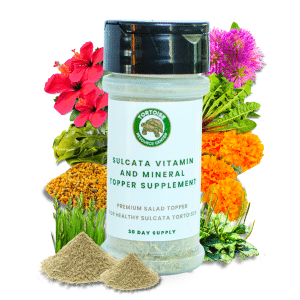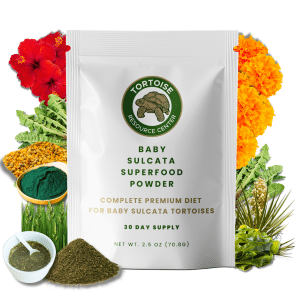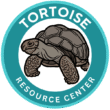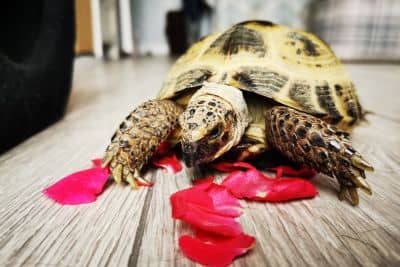Buying your first pet tortoise is certainly an exciting endeavor. However, you’ll need a variety of supplies to ensure your new pet remains healthy and enjoys a high quality of life.
In this article, I’ll be explaining some of the most important supplies you need for your tortoise below.
Environmental Supplies
Providing your tortoise with a proper environment is crucial for his health and well-being. This means you’ll not only need to purchase a suitable enclosure, but also the necessary climate control equipment, substrate, and enclosure furniture.
Enclosure
There are a variety of enclosure options for pet tortoises, and each offers a different set of benefits and drawbacks. Some tortoise keepers opt to build a custom enclosure, but most beginners will be best served by purchasing a tortoise table.
Front-opening plastic enclosures and large stock tanks are also options, though the former is often expensive, and the latter will require customization.
Lighting and Heating Equipment
Unless you’re maintaining your tortoise outdoors, you’ll need to purchase lighting and heating devices to ensure the climate remains within the targeted range and that your pet gets access to the UV rays he requires. There are a few different options, and each presents a different set of strengths and weaknesses:
- Mercury Vapor Bulbs: These lights are very convenient, as they provide heat, UVA light, and UVB light.
- Full-Spectrum Fluorescent Tubes: Though affordable, these lights do not produce much heat, so you’ll also need to buy separate heat-producing lights.
- Full-Spectrum LED Lights: These lights do not produce much heat either, though they do produce all of the UV light your pet needs.
- Compact Fluorescent Bulbs: These lights do not produce heat, but they do work with standard, incandescent-style fixtures, which can be helpful in some situations.
If you opt for lights that do not produce heat (such as any of the last three options mentioned above), you’ll need to purchase separate heat lamps or radiant heat panels.
Substrate
Keepers who maintain tortoises outdoors typically rely on the existing soil, grass, or other type of ground cover already in place. But if you’re keeping your pet indoors, you’ll need a tortoise-friendly bedding or substrate that is suitable for his enclosure. There are a variety of commercial substrates available, though bark-based mixes are generally the best option.
Enclosure Furniture
There are several key items you’ll want to include in your tortoise’s enclosure; you don’t want your pet living in what is essentially an empty box.
The most important thing to include is at least one hiding place (and it would be strongly preferable to include several). You can use realistic-looking items, such as corkbark, or you can use more utilitarian items. For example, an inverted plastic storage box with a hole cut in the side to serve as a door will work perfectly. Just be sure that the box is opaque to provide your tortoise with a sense of security.
It’s also a good idea to include a few other items which will serve as visual barriers and provide opportunities for mental enrichment. Driftwood is a great example, though some keepers opt for things like bricks or cinder blocks. Others prefer synthetic but natural-looking items, such as resin logs.
Dietary Supplies
Providing your tortoise with a healthy diet is crucial for ensuring proper growth and good health. Just note that this doesn’t only include food, but also containers for storing your pet’s food, dishes to offer the food in, and supplements that’ll help prevent nutritional deficiencies.
Are You Starving Your Tortoise?
Save 10% on premium tortoise food and supplements from Tortoise Resource Center on Amazon now using code BUYNOWGET10

Sulcata Vitamin & Mineral Topper Supplement
30-Day Supply | 2 oz (56 g)
$24.99

Baby Sulcata Tortoise Superfood Powder
30-Day Supply | 2.5 oz (70.8 g) Bag
$24.99
Food
Tortoises are primarily herbivorous animals, though some will eat the occasional insect or small mouse. However, this is rarely necessary for long-term health. Accordingly, most owners stick to a completely vegetarian diet for their pets.
With that said different tortoise species require slightly different dietary compositions. For example, sulcatas (Centrochelys sulcata) should be fed as many grasses and weeds as possible, with very little fruit included in the diet. By contrast, rainforest-dwelling species, such as red-footed tortoises (Chelonoidis carbonarius), aren’t as likely to experience serious health problems if fed a moderate amount of fruit.
In any event, some of the foods that typically work well for tortoise maintenance include:
- Apple
- Apricot
- Arugula
- Banana
- Blackberry
- Blueberry
- Brussel tops
- Carrot
- Chickweed
- Cilantro
- Clover
- Collard greens
- Coriander
- Corn poppy
- Cranberry
- Cucumber
- Dandelion
- Endive
- Escarole
- Frisee
- Goat’s beard
- Grape
- Hawkbit
- Hibiscus
- Honeysuckle
- Kale
- Melon
- Mulberry
- Mustard greens
- Nectarine
- Non-toxic grasses
- Parsley
- Parsnip
- Peach
- Pear
- Plantain
- Plum
- Pumpkin
- Radicchio
- Raspberry
- Rocket
- Romaine lettuce
- Roses
- Strawberry
- Turnip greens
- Watercress
You can also feed tortoises commercially produced tortoise pellets. These types of food are quite convenient; you should only use them as a portion (perhaps 25%) of your pet’s diet.
Food and Water Dishes
You’ll obviously need a water dish for your new pet, and because food placed on the ground may become contaminated with substrate or faeces, you should also offer your tortoise’s food in a dish.
The important thing is that you select dishes of the proper shape. Given the body design of tortoises, they can’t easily access deep bowls. They may even fall inside them and become trapped (which can lead to drowning – tortoises rarely swim well). Instead, opt for wide, shallow dishes that are safe and easy to access.
Note that you’ll need to wash these dishes with soap and water every day. This means that it is often helpful to purchase two complete sets, which will allow you to wash and dry one set while the other is in use.
Supplements
Despite the best attempts of their keepers to provide a healthy, well-rounded diet, tortoises occasionally suffer from vitamin or mineral deficiencies. Supplements are often used to prevent this from happening.
You should always discuss vitamin and mineral supplementation with your vet before offering these products to your pet. However, many tortoise owners provide a calcium supplement to their pets four to six times per week and a vitamin supplement once per week.
Other keepers forego calcium supplements and instead provide their tortoise with pieces of cuttlebone. The tortoise can then consume these as needed to obtain extra calcium.
Husbandry Supplies
There are also a variety of things you’ll need to care for your tortoise on a daily basis. While not exhaustive, the following list outlines most of the things you’ll need.
Soaking Containers
Most tortoises require regular soaks in room-temperature water to ensure proper hydration. Wide, shallow, polycarbonate boxes with lids are ideal.
Transportation Container
You shouldn’t transport your tortoise very much, as this can lead to stress. However, you will need to transport him from time to time, such as when visiting the veterinarian. Ventilated plastic boxes are good for this. Just be sure to add a bit of soft substrate to the bottom before using it.
Misting Bottle
While not always necessary for species hailing from arid climates, misting bottles make it easy to increase the humidity level inside your pet’s enclosure. Pressurized bottles are the best option, though they are a bit more expensive than simple spray bottles.
If you like, you can use an automated misting system instead of having to manually add water to the enclosure on a regular basis.
Disinfectant
Disinfectants are important for keeping your pet’s enclosure clean and keeping pathogens at bay. It is wise to discuss your choice with your vet, but most keepers either use commercial options or custom-blended, 5% bleach solutions.
It is important to note that bleach solutions and many other disinfectants are only effective on clean surfaces. In other words, you’ll need to clean the spot in question first using soap and water, then, you can follow up by applying disinfectant and wiping the area clean.
Digital Thermometer
A digital thermometer is imperative for tracking the ambient temperatures inside your tortoise’s enclosure. Digital models with probes are the best choice, as they can simultaneously monitor both sides of your pet’s enclosure.
Many keepers prefer using digital thermometers which also provide humidity information (hygrometers). These can be especially helpful for fledgling keepers, who’re still learning the ins and outs of tortoise maintenance.
Non-Contact Thermometer
While a typical digital thermometer is helpful for measuring ambient temperatures, it can also be helpful for measuring surface temperatures. This way, you can make sure your tortoise’s basking spot doesn’t become too hot to touch, for example. To measure surface temperatures, you need a non-contact, infrared thermometer.
UV Meter
Full-spectrum lights produce less and less UVB radiation over time. To ensure that your lights are still working properly and don’t require replacement, you’ll need to monitor them regularly with a UV-detecting device. There are very affordable UV sensor “cards” that will work, but true UV meters provide far better information (though they’re significantly more expensive).
Litter Scoop
Tortoises create a significant amount of waist, so you’ll need a litter scoop to facilitate regular enclosure cleaning. Some models even come with disposal bags, thereby providing additional value.
Citations
- Merck Veterinary Manual – Oxidizing Agents as Antiseptics and Disinfectants for Use With Animals
- Reptiles Magazine – Red-Footed Tortoise Care Sheet
- Arizona Exotic Animal Hospital – Basic Care: Sulcata Tortoise


